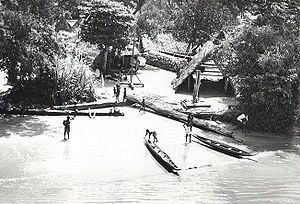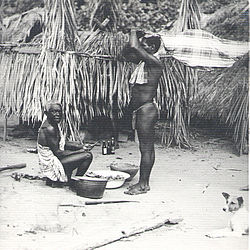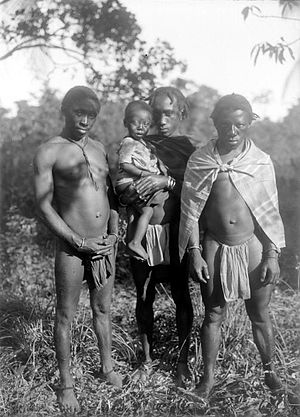- Maroon (people)
-
Maroons (from the word marronage or American/Spanish cimarrón: "fugitive, runaway", lit. "living on mountaintops"; from Spanish cima: "top, summit") were runaway slaves in the West Indies, Central America, South America, and North America, who formed independent settlements together. The same designation has also become a derivation for the verb marooning.
Contents
History
In the New World, as early as 1512, black slaves had escaped from Spanish and Portuguese captors and either joined indigenous peoples or eked out a living on their own.[1] Sir Francis Drake enlisted several 'cimaroons' during his raids on the Spanish.[2] As early as 1655, runaway slaves had formed their own communities in inland Jamaica, and by the 18th century, Nanny Town and other villages began to fight for independent recognition.[3]
When runaway slaves banded together and subsisted independently they were called Maroons. On the Caribbean islands, runaway slaves formed bands and on some islands formed armed camps. Maroon communities faced great odds to survive against white attackers, obtain food for subsistence living, and to reproduce and increase their numbers. As the planters took over more land for crops, the Maroons began to vanish on the small islands. Only on some of the larger islands were organized Maroon communities able to thrive by growing crops and hunting. Here they grew in number as more slaves escaped from plantations and joined their bands. Seeking to separate themselves from whites, the Maroons gained in power and amid increasing hostilities, they raided and pillaged plantations and harassed planters until the planters began to fear a mass slave revolt.[4]
The early Maroon communities were usually displaced. By 1700, Maroons had disappeared from the smaller islands. Survival was always difficult as the Maroons had to fight off attackers as well as attempt to grow food.[4] One of the most influential Maroons was François Mackandal, a houngan, or voodoo priest, who led a six year rebellion against the white plantation owners in Haiti that preceded the Haitian Revolution.[5]
In Cuba, there were maroon communities in the mountains, where escaped slaves had joined refugee Taínos.[6] Before roads were built into the mountains of Puerto Rico, heavy brush kept many escaped maroons hidden in the southwestern hills where many also intermarried with the natives. Escaped Africans sought refuge away from the coastal plantations of Ponce.[7] Remnants of these communities remain to this day (2006) for example in Viñales, Cuba [8] and Adjuntas, Puerto Rico.
Maroon communities emerged in many places in the Caribbean (St Vincent and Dominica for example), but none were seen as such a great threat to the British as the Jamaican Maroons.[9] A British governor signed a treaty promising the Maroons 2500 acres (10 km²) in two locations, because they presented a threat to the British. Also, some Maroons kept their freedom by agreeing to capture runaway slaves. They were paid two dollars for each slave returned.[10]
Beginning in the late 17th and early 18th centuries, Jamaican Maroons fought British colonists to a draw and eventually signed treaties in the 18th century that effectively freed them over 50 years before the abolition of the slave trade in 1807. To this day, the Jamaican Maroons are to a significant extent autonomous and separate from Jamaican society. The physical isolation used to their advantage by their ancestors has today led to their communities remaining amongst the most inaccessible on the island. In their largest town, Accompong, in the parish of St. Elizabeth, the Leeward Maroons still possess a vibrant community of about 600. Tours of the village are offered to foreigners and a large festival is put on every January 6 to commemorate the signing of the peace treaty with the British after the First Maroon War.[3][11]
In Suriname, which the Dutch took over in 1667, runaway slaves revolted and started to build their own villages from the end of the 17th century. As most of the plantations existed in the eastern part of the country, near the Commewijne and Marowijne rivers, the "Marronage" (literally: running away) took place along the river borders and sometimes across the borders of French Guyana. By 1740, Maroons had formed clans and felt strong enough to challenge the Dutch colonists, forcing them to sign peace treaties. On October 10, 1760, the Ndyuka signed such a treaty forged by Adyáko Benti Basiton or Boston, a former Jamaican slave who had learned to read and write and knew about the Jamaican treaty. The treaty is still important, as it defines the territorial rights of the Maroons in the gold-rich inlands of Suriname.[12]
Culture
 Maroon village, Suriname River, 1955
Maroon village, Suriname River, 1955
Slaves escaped frequently within the first generation of their arrival from Africa and often preserved their African languages and much of their culture and religion. African traditions include such things as the use of medicinal herbs together with special drums and dances when the herbs are administered to a sick person. Other African healing traditions and rites have survived through the centuries — see, for example, the accompanying photos of a medicine man and a protective charm from Suriname.
The jungles around the Caribbean Sea offered food, shelter and isolation for the escaped slaves. Maroons survived by growing vegetables and hunting. They also originally raided plantations. During these attacks, the maroons would burn crops, steal livestock and tools, kill slavemasters, and invite other slaves to join their communities. Individual groups of Maroons often allied themselves with the local indigenous tribes and occasionally assimilated into these populations. Maroons/Marokons played an important role in the histories of Brazil, Suriname, Puerto Rico, Haiti, Dominican Republic, Cuba, and Jamaica.
There is much variety among Maroon cultural groups because of differences in history, geography, African nationality, and the culture of indigenous people throughout the Western hemisphere.
Maroon/Marokon settlements often possessed a clannish, outsider identity. They sometimes developed Creole languages by mixing European tongues with their original African languages. One such Maroon Creole language, in Suriname, is Saramaccan. Other times the Maroons would adopt the local European language as a common tongue, for members of the community frequently spoke a variety of mother tongues.
The Maroons/Marokons created their own independent communities which in some cases have survived for centuries and until recently remained separate from mainstream society. In the 19th and 20th centuries, Maroon/Marokon communities began to disappear as forests were razed, although some countries, such as Guyana and Suriname, still have large Maroon populations living in the forests. Recently, many Maroons/Marokons have moved to cities and towns as the process of urbanization accelerates.
Geographical distribution
North America
Florida
The Black Seminoles who allied with Seminole Indians in Florida, were by far the largest and most successful Maroon community in North America.
Nova Scotia
Briefly, from 1796 to 1800, around 550 maroons, who had been deported from Jamaica after the Second Maroon War, lived in Nova Scotia. In 1800 they were sent to Sierra Leone.
Mexico
See Gaspar Yanga, Afro-Latin, Afro-Mexican.
Asian
Maroon communities were formed amongst the Afro Asians that resisted slavery.[13] These communities of maroons still inhabit the South Asian countries.
Central America
Panama
Main article: Cimarron people (Panama)A recently arrived slave, Bayano, led a rebellion in 1552 against the Spanish in Panama, and he and his followers escaped to found villages in the lowlands. Later these people, known as cimarrons, assisted Sir Francis Drake against the Spanish.
Honduras, Belize, Guatemala, Nicaragua
The Gulf of Honduras produced several types of maroon societies. Some of these were found in the interior of modern day Honduras along the trade routes by which silver mined in the Pacific side of the isthmus was carried down to coastal towns such as Trujillo or Puerto Caballos to be shipped to Europe. The English bishop of Guatemala, Thomas Gage, reported active bands of maroons numbering in the hundreds along these routes in 1648.
A second group that could be classified as maroons were the Miskito Sambu, who formed from revolted slaves on a Portuguese ship around 1640 who wrecked the vessel on the coast of Honduras-Nicaragua and blended in with the indigenous people over the next half century. They eventually rose to leadership of the Mosquito Coast, and led extensive slave raids against Spanish held territories in the first half of the eighteenth century.
A third group were the Garifuna, who were actually maroons on the island of Saint Vincent deported to the coast of Honduras in 1797. From their original landing place in Roatan Island, the Garifuna moved to Trujillo, and then groups of them spread south into the Mosquito Kingdom and north into Belize. See main article Garifuna.
Caribbean islands
Jamaica
Main article: Jamaican MaroonsEscaped slaves during the Spanish occupation of the island of Jamaica fled to the rugged interior and joined with the Taínos living there. Additional numbers fled during the confusion surrounding the 1655 British invasion. Run-away slaves continued to join them until the abolition of slavery. The main British complaint was that they occasionally raided plantations, and made expansion into the interior more difficult. These conflicts led to the First Maroon War in 1731 and the Second Maroon War in 1795. After which, approximately 600 maroons were deported to Nova Scotia, and later in 1800 removed to Sierra Leone. The only maroon settlement that remained after the Second Maroon War was Accompong, which had abided by its 1739 treaty with the British.
Haïti
See Mawon.
St. Vincent and Dominica
Similar Maroon communities emerged elsewhere in the Caribbean (St Vincent and Dominica for example).
Cuba
In Cuba, there were maroon communities in the mountains, where escaped slaves had joined refugee Taínos.[6] Remnants of these communities remain to this day (2006) for example in Viñales.[8]
Puerto Rico
In Puerto Rico, Taíno families from neighboring Utuado were found living in the Southwestern mountain ranges, along with the escaped Africans who intermarried with the Taíno. DNA genetic evidence shows that many Africans fled up the Camino Real into the mountains to escape the sugar plantations of Ponce. The Mandinka, Wolof & Fulani mtDNA African haplotype, L1b, is present here.[14] Taíno haplogroups A & C can also be found in this area.
South America
French Guiana and Suriname
Main article: History of Suriname#Slavery and emancipationEscaped slaves in French Guiana and Suriname fled to the interior and joined with indigenous peoples and created several independent tribes, among them the Saramaka, the Paramaka, the Ndyuka (Aukan), the Kwinti, the Aluku (Boni), and the Matawai. By the 1990s the maroons in Suriname had begun to fight for their land rights.[15]
Brazil
Main article: QuilomboOne of the best-known quilombos (maroon settlements) in Brazil was Palmares (the Palm Nation) which was founded in the early 17th century. At its height, it had a population of over 30,000 free people and was ruled by king Zumbi. Palmares maintained its independent existence for almost a hundred years until it was conquered by the Portuguese in 1694.
Colombia and Ecuador
Escaped slaves established independent communities along the remote Pacific coast, outside of the reach of the colonial administration.
See also
- Jamaican Maroons
- Gaspar Yanga
- Sranan Tongo
- Marie-Elena John
- Saramaka
- Capoeira
- Zambo
- Black Seminoles
- Black Indians
- Afro-Latin American
- Cimarron people (Panama)
- Maroon music
- Quilombo
Notes
- ^ "Sir Francis Drake Revived" in Voyages and Travels: Ancient and Modern. The Harvard Classics. 1909–14 paragraph 21.
- ^ "Sir Francis Drake Revived" in Voyages and Travels: Ancient and Modern. The Harvard Classics. 1909–14 paragraph 101.
- ^ a b Campbell, Mavis Christine (1988) The Maroons of Jamaica, 1655–1796: A History of Resistance, Collaboration & Betrayal Bergin & Garvey, Granby, MA, ISBN 0-89789-148-1.
- ^ a b Rogozinski, Jan (1999). A Brief History of the Caribbean (Revised ed.). New York: Facts on File, Inc.. pp. 155–68. ISBN 0-8160-3811-2.
- ^ "The History of Haiti and the Haitian Revolution". The City of Miami. http://www.ci.miami.fl.us/haiti2004/history.htm. Retrieved 2007-08-16.
- ^ a b Aimes, Hubert H. S. (1967) A History of Slavery in Cuba, 1511 to 1868 Octagon Books, New York;
- ^ The Hispanic American Historical Review, Vol. 66, No. 2 (May, 1986), pp. 381-382
- ^ a b "El Templo de los Cimarrones" Guerrillero:Pinar del Río in Spanish
- ^ Edwards, Bryan (1801) Historical Survey of the Island of Saint Domingo J. Stockdale, London;
- ^ Taylor, Alan (2001) American Colonies: The Settling of North America Penguin Books, New York;
- ^ Edwards, Bryan (1796) "Observations on the disposition, character, manners, and habits of life, of the Maroon negroes of the island of Jamaica; |b an a detail of the origin, progress, and termination of the late war between those people and the white inhabitants." in Edwards, Bryan (1801) Historical Survey of the Island of Saint Domingo J. Stockdale, London, pp. 303-360;
- ^ Alex van Stipriaan, Surinaams contrast (1995); Hans Buddingh', Geschiedenis van Suriname (1995/1999); Alex van Stipriaan/Thomas Polimé, Kunst van overleven (KIT, 2009)
- ^ Oka, R., & Kusimba, C. (2007). Siddi as Mercenary or as African Success Story on the West Coast of India. In J. C. Hawley, India in Africa Africa in India: Indian Ocean Cosmopolitans (pp. 203-224). Bloomington: Indiana University Press.
- ^ African DNA Project mtDNA Haplogroup L1b African DNA Project, archived May 8 2008 from the original
- ^ Case of the Saramaka People v. Suriname, Judgment of November 28, 2007, Inter-American Court of Human Rights (La Corte Interamericana de Derechos Humanos), accessed 21 May 2009
References
- Daughters of the Dust, 1991, film by Julie Dash taking place in 1902 off the coast of South Carolina and Georgia. It shows how, on an isolated island, a group of people manages to hold on to their Ibo customs and traditions. ISBN 0-525-94109-6
- Ganga Zumba, (1963), film by Carlos Diegues
- Quilombo, (1985), film by Carlos Diegues about Palmares, ASIN B0009WIE8E
- Hoogbergen, Wim S.M. Brill (1997) The Boni Maroon Wars in Suriname Academic Publishers, ISBN 90-04-09303-6
- Corzo, Gabino La Rosa (2003) Runaway Slave Settlements in Cuba: Resistance and Repression (translated by Mary Todd), University of North Carolina Press, Chapel Hill, ISBN 0807828033
- De Granada, Germán (1970) Cimarronismo, palenques y Hablas “Criollas” en Hispanoamérica Instituto Caro y Cuero, Santa Fe de Bogotá, Colombia, OCLC 37821053 (in Spanish)
- van Velzen, H.U.E. Thoden and van Wetering, Wilhelmina (2004) In the Shadow of the Oracle: Religion as Politics in a Suriname Maroon Society Waveland Press, Long Grove, Illinois ISBN 1577663233
- Price, Richard (ed.) (1973) Maroon societies: rebel slave communities in the Americas Anchor Books, Garden City, N.Y., ISBN 0-385-06508-6
- Honychurch, Lennox (1995) The Dominica Story Macmillan, London, ISBN 0333627768 (Includes extensive chapters on the Maroons of Dominica)
- Thompson, Alvin O. (2006) Flight to freedom: African runaways and maroons in the Americas University of West Indies Press, Kingston, Jamaica, ISBN 9766401802
- Learning, Hugo Prosper (1995) Hidden Americans: Maroons of Virginia and the Carolinas Garland Publishing, New York, ISBN 0815315430
- Campbell, Mavis Christine (1988) The Maroons of Jamaica, 1655-1796 : a history of resistance, collaboration & betrayal Bergin & Garvey, Granby, Mass., ISBN 0-89789-148-1
- Dallas, R. C. The History of the Maroons, from Their Origin to the Establishment of Their Chief Tribe at Sierra Leone. 2 vols. London: Longman. 1803.
- Sergey Slepchenko (2009) Nations of Latin America, Phoenix, Rostov-on-Don, ISBN 92-86-36414-2
Further reading
- Johnson, Brian D. "The Land of Look Behind." Equinox Magazine, September to October, 1983, pp. 49–65. A detailed article with many superb photos.
External links
- Maroon music and teaching methods
- Creativity and Resistance: Maroon Cultures in the Americas
- A good short history of the "Bush Negroes" of Suriname
- The Maroons, Hindustanis and others of Surinam
- "The Maroon Culture of Endurance by Helen Reidell".. A history of Jamaican Maroons. Also available in Américas Magazine, Vol. 42, January–February 1990, pp. 46–49.
Categories:- Ethnic groups in South America
- Slavery in the New World
- Maroons
- Peoples of the African diaspora
- Ethnic groups in the Caribbean
- Ethnic groups in Suriname
Wikimedia Foundation. 2010.



